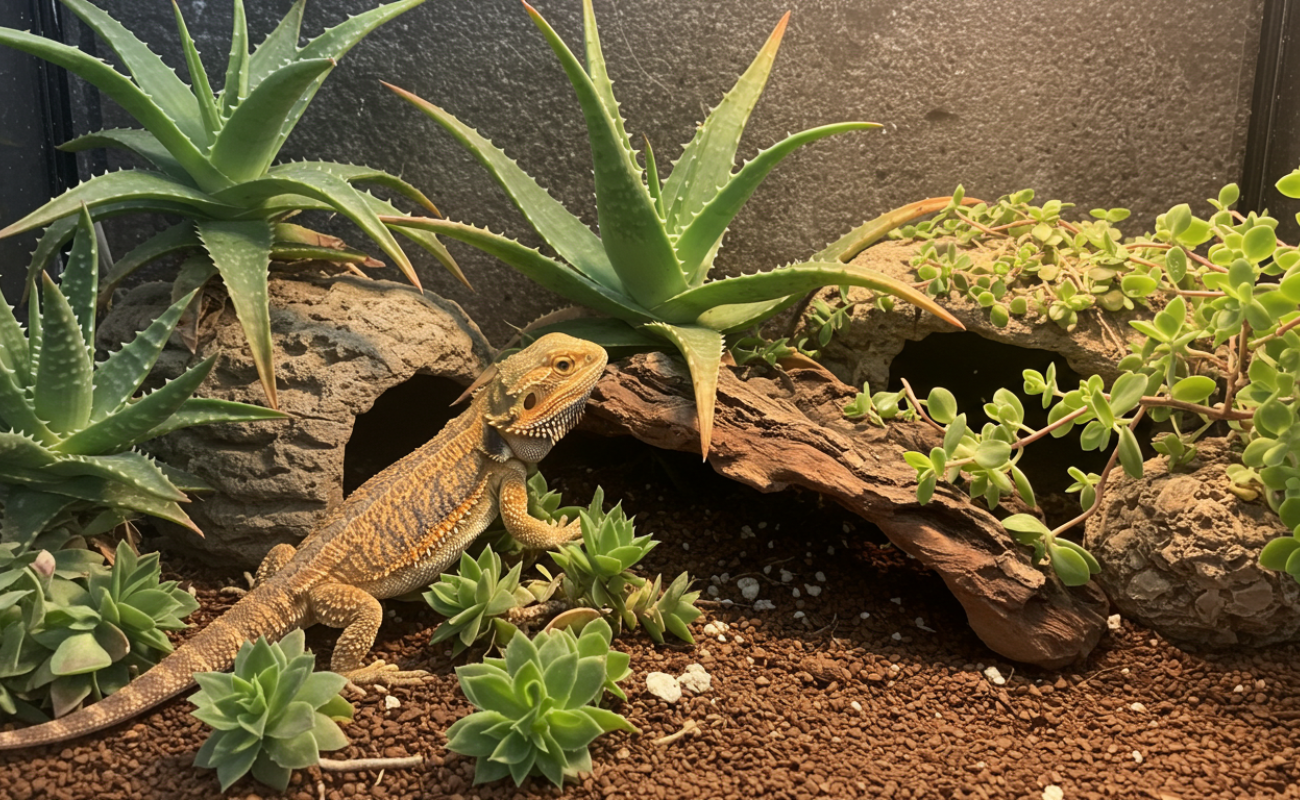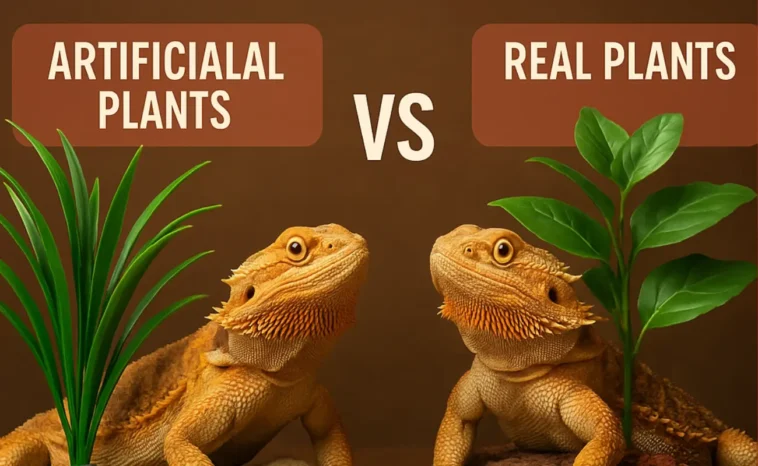Are Artificial Plants Better for Bearded Dragons or Real Plants?
Bearded dragons are one of the most popular reptiles to keep as pets, known for their friendly demeanor, unique appearance, and easy-going temperament. Whether you are a new bearded dragon owner or have had your pet for some time, providing an enriched environment is key to ensuring their health and happiness. One of the most effective ways to do this is by adding plants to your bearded dragon’s enclosure. But with so many options available, how do you choose the right plants? Are artificial plants better for bearded dragons or real plants?
In this article, we’ll answer the essential question, “Are Artificial Plants Better for Bearded Dragons or Real Plants?” and explore everything you need to know about keeping plants in a bearded dragon habitat. We’ll discuss whether real plants are safer for bearded dragons than artificial ones, the types of bearded dragon plants that are safe for your pet, and how to properly set up a bearded dragon enclosure with plants. You’ll learn about the benefits and drawbacks of both fake plants for bearded dragons and artificial plants for bearded dragons, and we’ll cover important considerations like can bearded dragons interact with artificial plants safely?
Additionally, we’ll provide tips on incorporating live plants into a bearded dragon tank and answer common questions, such as what to do if your bearded dragon eats a fake plant. If you’re also interested in ensuring your bearded dragon’s diet is as healthy as their environment, be sure to check out our guide on Can Bearded Dragons Have Arugula? Complete Nutrition, Safety & Serving Tips to learn about safe food options for your pet. By the end of this guide, you’ll be equipped with the knowledge to make an informed decision about which plants to add to your pet’s home, whether real or artificial.
Why Are Plants Important for Your Bearded Dragon?
Plants play a significant role in a bearded dragon’s enclosure for several reasons. They enhance the visual appeal of the terrarium while also offering vital benefits, such as enrichment, hiding spots, and even potential sources of food. Bearded dragons are natural foragers, and having plants in their environment helps simulate their natural habitat.
Live plants offer numerous advantages, such as maintaining humidity, improving air quality through photosynthesis, and providing natural hiding spots. Furthermore, for bearded dragons that enjoy grazing on plants, live plants can offer a safe, non-toxic snack. However, there are also risks involved, especially when choosing the wrong plants. Some plants can be toxic to reptiles, and others may not thrive in a terrarium environment.
In this article, we will dive into the specifics of both live and artificial plants for bearded dragons, helping you make the right choices for your pet’s enclosure.
Are Artificial Plants Better for Bearded Dragons or Real Plants?
When setting up your bearded dragon’s habitat, one of the first questions you’ll face is whether to use live or artificial plants. Both options have their merits, but the choice ultimately depends on your preferences, your bearded dragon’s needs, and the amount of maintenance you’re willing to commit to.
The Benefits of Artificial Plants
Minimal Upkeep: Artificial plants require very little attention, making them exceptionally easy to care for. They require no water, light, or pruning. This makes them a convenient choice for busy reptile owners who may not have the time or expertise to care for live plants.
Longevity: Unlike live plants, artificial plants retain their appearance over time and won’t wilt or deteriorate. They maintain their appearance throughout the year and won’t require replacement unless damaged. This durability can be especially useful in larger enclosures where plants may be trampled.
Safety: Artificial plants can be safer than live plants because there is no risk of your bearded dragon ingesting something harmful. However, it’s important to ensure that the artificial plants you choose are made from non-toxic materials.
The Benefits of Live Plants
Natural Habitat: Live plants contribute to creating a more natural and enriching environment for your bearded dragon. They provide cover and climbing areas, which encourage natural behaviors like exploration and hiding.
Air Quality and Humidity: Live plants help maintain proper humidity levels in the enclosure, which is especially important for tropical and desert species. Plants also improve air quality by releasing oxygen through photosynthesis.
Edible Plants: Certain live plants can be a nutritious snack for your bearded dragon. This allows your pet to exhibit natural foraging behaviors, which can be both physically and mentally enriching.

Safe Plants for Bearded Dragons
When choosing plants for your bearded dragon’s enclosure, safety is the top priority. Some plants can be toxic to reptiles, so it’s essential to select non-toxic species. Below is a list of safe plants that are perfect for a bearded dragon habitat.
1. Aloe Vera
Aloe vera is not only a safe plant for bearded dragons but also a hydrating snack. Bearded dragons may occasionally nibble on the leaves, which is fine as long as they are not consuming large quantities. Aloe thrives in warm, dry conditions, making it an ideal addition to a desert-themed enclosure.
2. Haworthia
Haworthia is a compact succulent native to the arid regions of South Africa. This plant is perfect for bearded dragons because it thrives in arid conditions and has a low-maintenance growth pattern. The leaves are safe for bearded dragons to munch on, and it won’t require a lot of care.
3. Echeveria
Echeveria is another succulent that grows well in arid conditions and is safe for bearded dragons. With over 150 species to choose from, you can find varieties that suit the size and aesthetic of your enclosure. Echeveria plants are non-toxic and provide a natural source of enrichment.
4. Prickly Pear Cactus
The prickly pear cactus makes a fantastic addition to a bearded dragon’s habitat, offering both functional and aesthetic value. Its hardy nature is well-suited to desert-themed enclosures, providing both shelter and occasional nourishment. While it does have spines, you can purchase spineless varieties, ensuring your pet won’t be harmed. The cactus pads can serve as an occasional treat, offering both food and shelter.
5. Dwarf Jade Plant (Portulacaria afra)
Dwarf jade plants are small, bushy plants that thrive in dry conditions. Native to South Africa, these plants mimic the natural habitat of bearded dragons and provide both cover and climbing opportunities. Bearded dragons can safely nibble on the leaves, but regular pruning may be necessary to prevent the plant from growing too large.
Risks of Using the Wrong Plants in a Bearded Dragon Enclosure
While adding plants to your bearded dragon’s habitat can be beneficial, there are also risks involved. Certain plants can be toxic to reptiles and should be avoided at all costs. For example, plants like Pothos, Philodendron, and Oleander are poisonous to bearded dragons and should never be used in their enclosure.
Bearded dragons are curious creatures and may attempt to nibble on plants, so it’s essential to ensure that all plants in the enclosure are safe. If you’re ever unsure whether a particular plant is safe, it’s best to err on the side of caution and consult a veterinarian or herpetologist.
Setting Up the Perfect Bearded Dragon Enclosure
When creating an enclosure for your bearded dragon, there are several key elements to consider. It’s not just about adding plants – it’s about creating an environment that mimics their natural habitat and supports their overall well-being.
Temperature and Lighting
Bearded dragons are cold-blooded creatures, which means their body temperature is regulated by the surrounding environment and external heat sources. To stay healthy and regulate their metabolism, they depend on their environment to provide the necessary warmth.
As a result, it’s essential to establish a temperature gradient within their habitat to allow them to regulate their body heat effectively. One side should be warmer (95-105°F), and the other should be cooler (75-80°F). UVB lighting plays a crucial role in your bearded dragon’s health by helping them synthesize vitamin D3, which is necessary for calcium absorption.
Substrate
The substrate in the enclosure should be safe and easy to clean. Avoid using sand, gravel, or loose bedding materials, as they can cause impaction if ingested. Instead, opt for newspaper, reptile carpet, or ceramic tile. For a more natural look, you can use a bioactive substrate that includes soil and organic matter, which can support live plants.
Hiding Spots and Enrichment
Providing hiding spots for your bearded dragon is essential to reducing stress. You can use ceramic pots, rocks, or branches to create hideaways. Enrichment in the form of climbing branches, safe plants, and rocks will encourage natural behaviors, making your bearded dragon feel more at home.
Conclusion
Incorporating plants into your bearded dragon’s enclosure is a great way to enrich their environment and promote their health. Whether you choose live or artificial plants, it’s important to select safe, non-toxic options that support their natural instincts. By choosing the right plants and setting up an appropriate habitat, you’ll create a thriving, comfortable environment for your pet.
Remember to always research plant safety and maintenance requirements before adding new plants to the enclosure. With the right care and attention, your bearded dragon’s enclosure can become a beautiful and stimulating space that closely mirrors their natural habitat.





